#robert mccloskey
Text

from Blueberries for Sal, Robert McCloskey
14 notes
·
View notes
Text

So you get invited to a 1 year-old birthday party... What to do? A bottle of scotch might be out of question.. probably.. what to bring, what to bring?! Eureka! I have found it.. 🦆🫐
@thethirdman8 🦆 Make way! 🫐 🫐 🫐 kuplink, kuplank, kuplunk... oh and 🐻🐻
#robert mccloskey#blueberries for sal#make way for ducklings#pretty pretty good#can't miss#thethirdman8#duck me baby#duck me hard#1941#boston#public garden#1948#maine#bears
22 notes
·
View notes
Text
1 note
·
View note
Text
0 notes
Text
One Morning in Maine, 225 People Went to the Library
Books or beach? In a coastal town, the decision is easy, thanks to artwork by the author of “Blueberries for Sal” and “Make Way for Ducklings.”

by Elisabeth Egan
It was a beach day, by Maine standards — slightly overcast and moderately balmy, with a hint of balsam in the air. But on a peak-summer morning in July, 225 people steered clear of state parks and went to Curtis Memorial Library in Brunswick instead.
They were young and old, in strollers and on walkers and strutting the latest technical sandals. They wore pigtails, baby slings, ironic T-shirts, a head scarf, a lobster hat, a crown, a tiara and halos of white hair. Many carried colorful hardcovers and paperbacks that appeared to have served multiple generations of readers.
The crowd wasn’t at Curtis to meet a celebrity memoirist or best-selling novelist. They were there for a children’s book event: Sarah McCloskey, the real-life inspiration for “Blueberries for Sal” (1948) was at the library to read a handful of classics by her father, Robert McCloskey, who also wrote “Make Way for Ducklings” (1941) and “One Morning in Maine” (1952), among others. The event was one of several celebratory occasions planned around The Art of Wonder, an exhibit of 68 original illustrations by the two-time Caldecott Award-winning author, which will be on display until Oct. 15.
As “Sal” McCloskey, now 78, settled into an armchair at the front of Morrell Reading Room, a hush fell over the undulating sea of children at her feet. It was as if an adult version of Matilda, Pippi or Eloise had just strolled into the room in a yellow T-shirt and khakis. McCloskey’s hair is salt and pepper — gone is the tousled mop her father drew with India ink — but she still felt familiar, like an old friend you haven’t seen since preschool. This sense of abiding affection was a powerful reminder that certain characters imprint on our DNA — and that the writers and artists who conjure them have a bit of magic in their fingertips.
At the beginning of her introductory remarks, Joyce Fehl, the library’s development and marketing manager, asked the crowd, “Who has goose bumps?”
READ MORE
#robert mccloskey#children's books#libraries#librarians#book tumblr#illustrators#book publishing#childrens literature#authors#writers
1 note
·
View note
Text
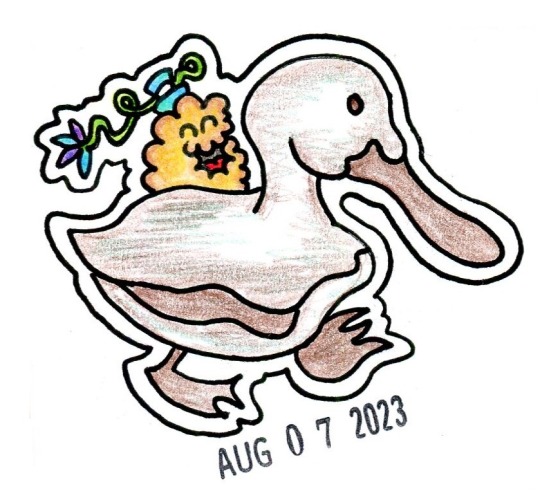
🦆 #1223
1 note
·
View note
Photo

Make Way for Ducklings Unisex T-Shirt | Out of Print
0 notes
Text
oh my god we were at the library and my sister said to the baby "ok the book we're looking for is by Robert McCloskey, which starts with an M, like mama! can you find the M section for me?" and he looked around for a bit and then ran straight to it!! I almost keeled over
he can also apparently now recognize D (for daddy), G (for granddaddy), and the first letters in my and my mom's names
77 notes
·
View notes
Text
Cincinnati Gasped At The Idea Of ‘Trial Marriages,’ But Practiced Them Anyway
Judge Stanley Struble was fed up. As he looked over his docket in 1929, the judge grew suspicious that the Hamilton County Courts were being forced into abetting the immoral practice known as the “trial marriage.” It was increasingly common, Struble noticed, for Ohio teenagers to elope to Northern Kentucky, where marriage laws were much looser, and then, when the match proved unsatisfactory, to ask Ohio courts to annul the union on the basis of their immaturity. Judge Struble told the Cincinnati Post [30 November 1929]:
“These marriages seem to be becoming a habit among youthful couples, and clerks who issue licenses in such cases seem to be interested only in obtaining the fees, the same as would appear the case of those who perform these marriage ceremonies.”
Judge Struble held two annulment appeals aside until further investigation revealed the motivation behind those cases. The couples placed under the microscope were Leola Stouder McCloskey, who testified that she was only 16 when she married 19-year-old William McCloskey in Covington in 1926 and Elizabeth Bruenen Edwards, married at age 16 to Robert Edwards in Newport, also in 1926. In neither case did any testimony reveal why each couple had waited three years before seeking annulment.
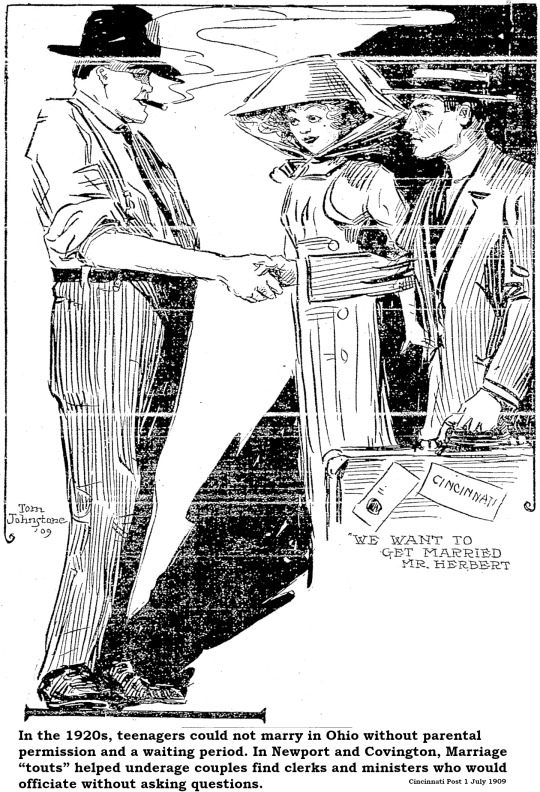
Judge Struble was reacting to a controversial topic that had stirred debate in Cincinnati since at least 1906 – the idea that temporary marriages, giving couples a no-fault option to leave the marriage after a brief trial period, were the solution to the social problems of divorce. The idea was most popularly promoted by pioneering anthropologist Elsie Clews Parsons in her 1906 book, “The Family.” Almost from the day it was published, Doctor Parsons’ book was widely (if surreptitiously) read and just as widely condemned. The Post [23 November 1906] was editorially outraged, claiming that it was already too easy to terminate a marriage:
“The reform is needed in the other direction. We need to get rid of the feeling that marriage is a mere experiment.”
In condemning the concept of trial marriage, The Post had lots of company. Doctor Sarah Siewers, one of Cincinnati’s foremost suffragists, told the Post [20 November 1906]:
“Abominable! Who ever heard of a woman making such a fool of herself? Why, the plan Mrs. Parsons proposes means the end of society and the home and a reversal to the dark ages. The whole thing is disgusting to me. The only solution to the divorce problem is for men to behave themselves better and for women to insist on being treated as equals, not as inferiors or slaves.”
Mrs. Jessie Oliphant, described as a “Norwood club woman,” declined to comment:
“It is a very serious problem that Mrs. Parsons has started out to solve. The subject is very distasteful to me and I would rather not discuss it.”
Judge John A Caldwell was four-square against the idea:
“Trial marriage could be no marriage at all, and would ultimately destroy the marriage relation altogether. Such a system would destroy the home, the greatest of all our institutions, and would illegitimatize thousands of children”
The more opinions the Post published in opposition to trial marriage, the more letters it received in support of the concept. Furniture dealer Maurice C. Williams wrote [26 November 1906]:
“The views of Mrs. Parsons, as expressed in the book, ‘The Family,’ are as the faint rays of a dawning day which become gradually more resplendent until the shimmering light gives way to the sun in all its glory, casting its benignant influence over all. So it will be with man. The ideas advanced are along the lines of altruism.”
In the same issue, cabinet maker Fred Walthard (Yes, most of the supporters of trial marriage were men.) wrote:
“The majority of marriage ceremonies still take place in churches or similar places, where a priest is the ‘matador.’ But you don’t find one couple out of a thousand that are advanced enough to seek the judgement of a reliable physician concerning their match. I am afraid the divorce problem will never be solved so long as law and religion have everything to say about marriage and science nothing.”
An unnamed judge of the Hamilton County courts dabbled in statistics and informed the Cincinnati Post [28 October 1909] that all marriages were trial marriages anyway, and that he had the data to prove it. Looking over his cases for the past month, the judge found 140 divorce suits. Of these, 107 requests for divorce were filed by couples married less than 10 years:
“’Proving,’ said a Judge of the Hamilton-co. courts, ‘that marriage is naturally a 10-year-trial proposition. The figures indicate to me that couples who manage to live together for 10 years will in most cases stay married the rest of their lives, and the couples unsuited for each other usually find it out before 10 years are over.”
The anonymous judge scoffed at the idea of a trial marriage, since his experience showed that all marriages had a natural trial period built in. A closer look at his numbers revealed that 73 divorces – more than half of the month’s total – involved marriages that had not yet marked a five-year anniversary.
Spotting a saucy topic, the entertainment industry jumped on the trial marriage bandwagon. Cincinnati audiences enjoyed a play and a couple of silent films based on the trial marriage concept.
As late as the rock ‘n’ roll era, the Post’s medical advice columnist, Dr. George W. Crane, warned young women to avoid over-sexed men who proposed this immoral arrangement [16 September 1958]:
“Trial marriage usually is suggested by a person who may feel sexual infatuation but no true love. And there is a whale of a difference! Trial marriage definitely does NOT benefit the girl. She makes the sacrifices and is likely to be left pregnant and unable to earn a living for herself.”
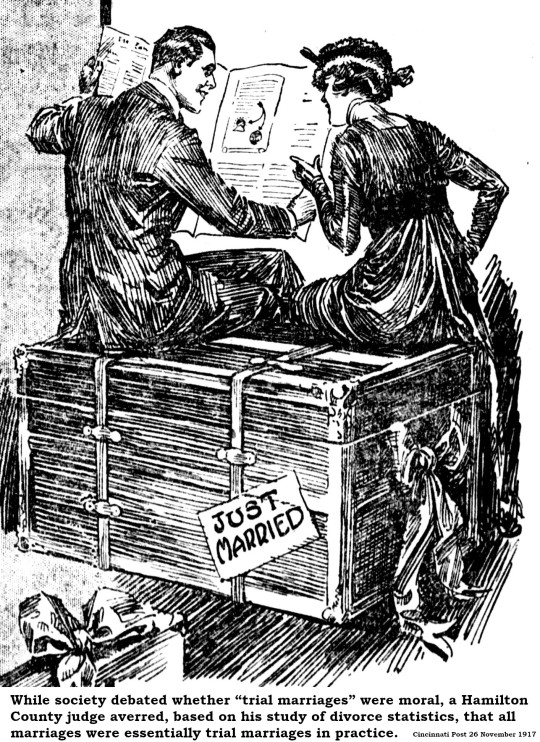
6 notes
·
View notes
Text

"HUNGER STRIKE ENDS AT PEN IN ITS 111TH HOUR," Baltimore Sun. May 21, 1933. Page 20.
----
Prison Gandhis Finally Yield To Call Of Empty Stomachs
---
'ACE CRIMINALS GO FOR MILK TOAST
----
Group Still Kept Segregated After Wage Protest Collapses
---
The hunger strike in which fourteen prisoners at the Maryland Penitentiary united Tuesday morning ended in its one hundred and eleventh hour at 9.45 o'clock last night, Warden Patrick J. Brady announced.
At that hour, he said, the fourteen recalcitrants, whose names read like a "Who's Who in Maryland Crime." sent word to him that they were ready to eat.
As soon as the message was received, the warden said he had set before the strikers a meal of soup, milk and toast, specially prepared in the diet kitchen of the prison hospital, the regular penitentiary kitchen being closed at night. They will stay where they are however -and this may be for a long time - until it has been decided what to do with them, and whether to risk letting them mingle with other prisoners.
Fourteen Capitulate As One
The fourteen capitulated as one to the pangs of hunger, according to Warden Brady, who added that throughout the day in the cells where the fourteen were segregated there had been an intermittent hum of surrender talk.
Eighteen men have been living in that west-wing special segregation tier on the fifth floor ever since the prison wage strike last December, but only fourteen of them decided to emulate Gandhi and let their stomachs be their instruments of protest.
Those Who Gave Up
The names of the fourteen, nearly all of whom are serving long terms for crimes ranging from burglary, robbery and assault to murder, follow:
RAWLINGS WHITTEMORE
LEO MERCER,
JAMES MCCLOSKEY,
JOHN KELLER,
AUGUST BEYERS,
JOHN RYAN,
ROBERT MINNERS,
RAYMOND HILL,
EDWARD WEST,
CHARLES KRAMER,
HUNTER LEWIS,
JERRY OFFEREDA,
FRANK CAMPBELL,
EDWARD HARLING
One Negro In Group
Campbell is the only Negro in the group, which began its strike five days ago by refusing breakfast Tuesday morning.
Warden Brady said that during the final twenty-four hours of the strike he had instructed the guards watching the strikers to tell them they would "gain nothing by refusing to eat and merely save the State money on its food bill." During the day, he said, several strikers were heard from time to time urging their colleagues to answer their stomachs' call, but unity did not come until nearly 10 o'clock.
#baltimore#maryland penitentiary#maryland history#hunger strike#prison hunger strike#solitary confinement#classification and segregation#prison strike#prison industries#the great depression#history of crime and punishment#prisoner protest#racism in america#african americans#passive resistance
1 note
·
View note
Text

Lentil by Robert McCloskey
2 notes
·
View notes
Note
top 5 children’s books?
(this was number 17)
From the Mixed-Up Files of Mrs. Basil E. Frankweiler by E. L. Konisburg
The Witch of Blackbird Pond by Elizabeth George Speare
The Saturdays (and all of the Melendy family books) by Elizabeth Enright
One Morning in Maine by Robert McCloskey
The Length of a String by Elissa Brent Weissman
These are all childhood favorites of mine except the last one, which I just read with my 11yo this year for homeschool, and which we both loved.
Thanks, Shelby! :)
send me book asks
11 notes
·
View notes
Text



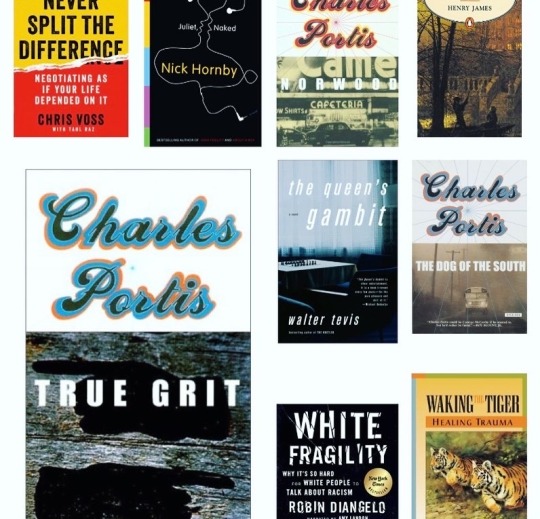
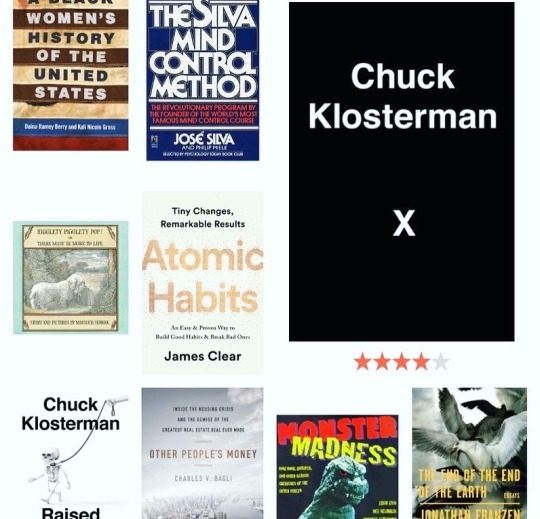
What did you read this year? What were your favorites? What do you recommend (as long as it’s not from Oprah’s Book Club list)? Here’s my list…
Books (Including Novellas and Short Stories) That I Read 2022 (*asterisks by the ones I recommend):
1. Atomic Habits (2018) by James Clear
2. Billy Liar (1963) by Keith Waterhouse (7.9 stars out of 10)
3. A Black Women’s History of the United States (2020) by Daina Ramey Berry and Kati Nicole Gross (6.4 stars out of 10)
4. *Cat’s Cradle (1963) by Kurt Vonnegut (9.9 stars out of 10)
5. *Chuck Klosterman X: A Highly Specific, Defiantly Incomplete History of the Early 21st Century (2017) by Chuck Klosterman (8 stars out of 10)
6. (The) Compound Effect (2010) by Darren Hardy
7. *Consider This (2020) by Chuck Palahniuk (8.9 stars out of 10)
8. *Dog of the South (1979) by Charles Portis (8.8 stars out of 10)
9. (The) End of the End of the Earth: Essays (2018) by Jonathan Franzen (6.3 stars out of 10)
10. *Fight Club (1996) by Chuck Palahniuk (10 stars out of 10)
11. Furiously Happy (2015) by Jenny Lawson (6 stars out of 10)
12. *(A) Good Man is Hard to Find (1953) by Flannery O’Connor (9 stars out of 10)
13. Heartburn (1996) by Nora Ephron (7.5 stars out of 10)
14. *Higglety Pigglety Pop! or There Must Be More to Life (1967) by Maurice Sendak (8.1 stars out of 10)
15. *Homebodies (1954) by Charles Addams (8.5 stars out of 10)
16. *Imperial Bedrooms (1985) by Bret Easton Ellis (8.3 stars out of 10)
17. *Invasion of the Body Snatchers (1955) by Jack Finney (8.9 stars out of 10)
18. Juliet, Naked (2009) by Nick Hornby (5.8 stars out of 10)
19. *(The) Man Who Lost His Head (1942) by Claire Huchet Bishop and Robert McCloskey (9 stars out of 10)
20. Monster Madness: Godzilla, King Kong and other Classic Creatures of the Silver Screen (5.9 stars out of 10)
21. Never Split the Difference (2016) by Christopher Voss (5.5 stars out of 10)
22. Nobody Move (2009) by Dennis Johnson (6.2 stars out of 10)
23. *Norwood (1966) by Charles Portis (8.2 stars out of 10)
24. Other People’s Money: Inside the Housing Crisis and the Demise of the Greatest Real Estate Deal Ever Made (2013) by Charles V. Bagli (5.6 stars out of 10)
25. Pity the Reader: On Writing with Style (2019) by Kurt Vonnegut, Suzanne McConnell (6.1 stars out of 10)
26. (The) Queen’s Gambit (1983) by Walter Tevis (6 stars out of 10)
27. *Raised in Captivity (2019) (Chuck Klosterman) (8.4 stars out of 10)
28. (The) Silva Method Mind Control (1991) by Jose Silva (4.5 stars out of 10)
29. (The) Time Machine (1895) by H.G. Wells (7.9 stars out of 10)
30. *True Grit (1968) by Charles Portis (9.5 stars out of 10)
31. (The) Turn of the Screw (1898) by Henry James (6.5 stars out of 10)
32. Turtles All the Way Down (2017) by John Greene (5.4 stars out of 10)
33. Waking the Tiger (1997) by Peter A. Levine (5.7 stars out of 10)
34. White (2019) by Bret Easton Ellis (7.5 stars out of 10)
35. White Fragility (2016) by Robin DiAngelo (1 star out of 10)
36. *Wise Blood (1952) by Flannery O’Connor (8.6 stars out of 10)
2 notes
·
View notes
Text
0 notes
Text
0 notes
Link
Check out this listing I just added to my Poshmark closet: 3/$12 Blueberries for Sal Paperback.
0 notes